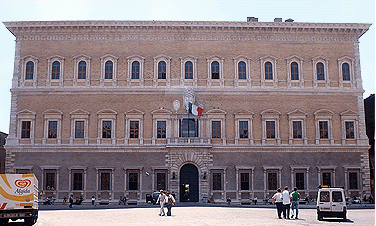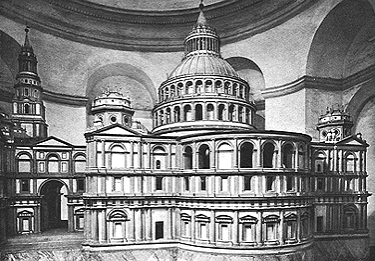Antonio da Sangallo the Younger
1484-1546
LIFE AND CAREER
Family Background
Antonio da Sangallo the Younger was the third successful architect of the Sangallo family of Florence. Antonio is referred to as "the Younger" to distinguish him from his uncle Antonio da Sangallo the Elder, who also worked as an architect.
Training and Influences
Antonio was a woodworking apprentice to his uncle, Giuliano da Sangallo, in the latter's workshop.
Around 1503 he began working in Rome for Bramante, whose influence is evident in some of his work. He was also influenced by Raphael, with whom he worked from 1514 to 1520.
Work at the Vatican
●Before 1514. When Pope Julius II came to power, he began several major projects at the Vatican, namely the building of a new St. Peter's, the construction of the Belvedere Court, and the addition of a façade to the Vatican palace. These projects were continued under Leo X, Clement VII, and Paul III. Bramante was the chief architect for all of the projects, and Antonio was put in charge of building the centering for the crossing arches of St. Peter's. His training in construction amply qualified him for the carpentry project.
●1514-1520. After Bramante's death in 1514, Raphael became chief architect of the Vatican projects, and in 1515, Antonio became his assistant. Antonio worked primarily as a carpenter, but under the influence of Raphael, he developed the planning and designing skills of an architect.
●1520-1527. Following the death of Raphael in 1520, Antonio was assigned his position as chief architect, and work continued, except under Hadrian VI, until the Sack of Rome in 1527.
●1534-1546. When work resumed in 1534 under Paul III, Antonio was re-appointed as chief architect, and except for periods when progress was suspended due to a lack of papal funding, he worked in this capacity until his death in 1546.
Patronage by Alessandro Farnese
Many of Antonio's most important commissions originated with Alessandro Farnese. As a cardinal, Alessandro commissioned him to design and build the Farnese palace, and as Paul III, he made Antonio the chief architect of the Vatican projects in 1534 when Rome was beginning to recover from the Sack.
Fortifications
Because of his training and experience in carpentry and general construction, Antonio was often called upon during his career to design fortifications, as did his uncles and many other architects.
In 1526, Clement VII commissioned Antonio to assess the state of fortifications of Papal possessions. Assisted by Sanmicheli, he traveled around Italy inspecting fortifications.
At the port city of Civitavecchia, he completed the encirclement of a fortress using many aspects of the new system of fortifications known as the trace Italienne.
ARCHITECTURAL WORKS
Works in Rome
♦Palazzo Palma-Baldassini, 1514-22. Antonio's design for the façade of the Palazzo Palma-Baldassini, a seven-bay palace for Melchiorre Baldassini, anticipated that of the Palazzo Farnese, whose present form was worked out in the late 1530s. Both palaces have quoins at the corners, accentuated entrances, windows on the ground stories, window trims that differ on each story, and plain, low-textured wall surfaces on all stories.
♦St. Peter's, Vatican. Antonio made little progress on St. Peter's in the 1530s and 1540s, which is fortunate because his design lacked unity and coherence. His successor, Michelangelo, obtained permission to pull down most of his work and return to a centralized design. Sangallo's design is preserved by a wooden model executed by Antonio Labacco.
♦Vatican Palace Façade, Vatican. Antonio worked on Bramante's façade addition to the old Vatican Palace. To support the extra weight created by Raphael's addition of a fourth story, Antonio filled in the ground-story arches.
♦Belvedere Court, Vatican. Before Antonio came to the Belvedere Court project, much of the east gallery had been constructed according to Bramante's design and modified by Peruzzi, who filled in the open arcade to increase its stability. In the 1540s, Antonio completed the east gallery's first three stories plus three bays of a fourth story.
♦Palazzo Farnese, 1517-89. Antonio's finest work is the Palazzo Farnese, which was extremely influential. Although he worked on it for much of his life, it was ultimately completed by others. Antonio determined the plan, the design of the windows, and the masonry of tan brick with quoins on the corners. Antonio completed many major parts of the building, including the main entrance and vestibule, two stories of the courtyard, and the ground story loggia on the rear wing. He died in 1546 before the cornice and rear wing were begun. His successor, Michelangelo, changed the design of the cornice to one that was far larger in relation to the palace's immense size. In the same vein, he enlarged the upper section of the entrance, making it more emphatic and ornate. In the courtyard, Michelangelo modified Antonio's three-stories of superimposed loggias by closing the upper stories and inserting windows.
Military Architecture
♦Fortress phase of Villa Farnese, Caprarola, 1515. Early in his career, Cardinal Alessandro Farnese, who later became Paul III, commissioned Antonio da Sangallo the Younger and Baldassare Peruzzi to design a fortress at a family property at Caprarola. It is clear that they designed the pentagonal perimeter, but it is not clear whether they or Vignola, who later turned the fortress into the Villa Farnese, designed the circular court at its center. In converting Antonio's fortress, Vignola left the moat dry and used the platform roofs of Antonio's bastion as terraces.
♦Fortezza da Basso, Florence, 1534. One of Antonio's most impressive fortresses is the Fortezza da Basso in Florence. It was commissioned by Pope Clement VII's illegitimate son, Alessandro de' Medici, who governed Florence as a Duke. (His rule had been sponsored by Charles V, whose imperial forces besieged and took Florence in 1529-30 as part of a deal between the Emperor and the Pope.)
♦Rocca Paolina, Perugia, 1540-43. The Rocca Paolina in Perugia was commissioned by Paul III, who felt triumphant at having finally taken Perugia into the Papal States. The fortress was despised by the citizenry because it symbolized their loss of liberty, and when the old order fell in the nineteenth century, the Rocca Paolina was destroyed.
♦Double Bastion at Porta Ardeatina, Rome, 1535-42. Antonio da Sangallo the Younger designed the bastions at Porta Ardeatina as part of a new beltway of fortifications around Rome for Pope Paul III. The Pope wanted to improve Rome's defensive capacity, whose inadequacy had been demonstrated by the Sack of Rome in 1527. The doubling of the flanks dramatically increased the number of gun emplacements. This bastion could accommodate sixteen heavy weapons and eight lighter ones. A raised gun platform called a cavalier stood above the open deck, which was also a gun platform. Casemates below allowed greater protection for the artillery men. To prevent the enemy from tunneling below the walls, listening posts were established underneath the ditch. Soldiers with listening horns occupied horizontal shafts that were reached through well shafts. Flues above the vertical chambers ventilated the shafts.
♦Completion of Enceinte of Fortress Michelangelo, Civitavecchia, 1530s. Under Pope Paul III, Antonio was engaged to complete the Fortress Michelangelo at the port city of Civitavecchia, which had been begun under Pope Julius II. This fortress is significant for achieving the first complete enceinte (belt of walls and bastions) using the new trace italienne system. The octagonal tower at the center on the harbor side reflects the new use of angular bastions, but the round bastions on the corners reflect the fortress' having been begun before angled bastions were in use. The fortress is named for Michelangelo, who made an addition to the tower in the center.
|
Palazzo Farnese, Rome, 1517-89
Rear of model of St. Peter's designed by Antonio da Sangallo the Younger and built by Antonio Labacco. See Front of model.
|



 Add Placemark
Add Placemark Go Back
Go Back 






